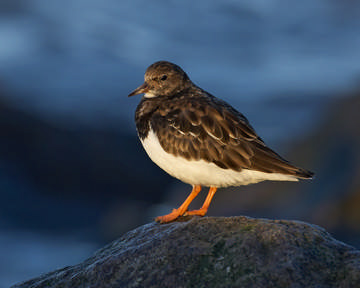Turnstone (Arenaria interpres)

Turnstone © Richard Steel
Turnstones breed in the high Arctic, to within 500 miles of the North Pole on Ellesmere Island, Canada, and undertake prodigious migrations to spend every winter within the same small area around our coasts. They are a long-lived bird, and extremely site-faithful. During winter 1990/ 91, for instance, Merseyside Ringing Group caught 339 Turnstones at night roosting on the drained New Brighton Marine Lake (SJ39C) and 43 of them had been ringed on the north Wirral or at Seaforth over ten years previously, the oldest being three from 1977 returning for at least their fourteenth winter (Norman & Coffey 1994). Two of them were doomed not to return, however, being found dead in July 1996 on breeding grounds in north-west Greenland and in June 1999 in Baffin Island, Canada, the latter in the area normally occupied by Turnstones that winter in the USA.
Turnstones probably have the most varied diet of any wader and have been recorded scavenging many bizarre items on the tideline including dog food, potato peels, cheese, oatmeal, soap, gull excrement, and the flesh of dead animals, including birds, a sheep, a wolf, a cat, and a human corpse, culminating in a note in British Birds entitled ‘What won’t Turnstones eat?’ to which the answer appeared to be ‘almost nothing!’ (Gill 1986). Their more natural food comprises shore crabs, mussels, periwinkles and crustaceans, using their strong bill to probe and chisel under stones and seaweed. Turnstones studied on Egremont shore (SJ39B) in 1989 fed almost exclusively on barnacles.
The Turnstone’s status in the county has changed considerably in the last one hundred years. Brockholes (1874) said that they were scarce in the 19th century, but by the beginning of the 20th century Coward (1910) regarded the species as not uncommon as a passage migrant, although in winter there were only two records, both from Red Rocks, of a single bird in January 1907 and a flock of six in January 1909. They must have changed their habits markedly in the next thirty years because Hardy (1941) knew the species regularly at Hilbre throughout the winter, counting a flock of 72 on 8 January 1939. Bell (1962) noted that their chief haunt was the Dee estuary, particularly around Hilbre and Hoylake, with flocks of 400 to 600 birds on autumn passage, but the numbers fell away in October and November to leave up to 100 or so wintering. On the Mersey estuary it was much less common, with small numbers reported from Bromborough, in Tranmere Bay, and Frodsham Marsh.
The county bird reports from 1964 onwards made no mention of Turnstones in winter until a count of 300 at Hilbre in February 1977, and by 1982 the ‘resident’ population there was usually 200-500 birds (Craggs 1982). This continues true of Hilbre Island to the present day, with occasional exceptional figures like the 601 counted in January 1994, although flocks are more normally towards the bottom end of this range. Elsewhere on north Wirral, high counts were also reported from Leasowe Bay, 250 on 9 February 1980 and 550 on 29 December 1982, with the species’ versatility again displayed when 400 roosted and fed on school fields at Leasowe on 12 January 1986. During the 1980s New Brighton emerged as another important roost site, and the importance of Egremont shore for feeding was realised by 1988, with c.300 birds there in December 1988, these birds roosting at Leasowe. Low-water counts were instigated in the Mersey Narrows from New Brighton to Egremont, revealing some massive figures including 1,100 in February 1995, the county’s record of 1,785 on 5 February 1997, and 1,719 on 30 November 1998, but numbers reduced following construction of three long groynes to stabilise the beach wall, with 678 birds there on 16 January 2000, and Cheshire and Wirral Bird Reports include no further counts although the 2004 report noted that ‘good numbers’ were present there.
The Mersey Narrows held, at times, the third largest concentration of Turnstones in the UK, but its importance was sadly not recognised for many years because the birds roosted on the north Wirral and all the WeBS counts were lumped in with those for the Dee Estuary. The site was eventually notified as SSSI in August 2000, and the Mersey Narrows and North Wirral Foreshore has been notified to the government as a potential Special Protection Area under the European Birds Directive.
Conservation status for a site cannot, however, make species immune from wider trends and the numbers of Turnstones wintering in England fell considerably during the 1990s, back to about the level of the early 1970s; it appears that the Cheshire and Wirral figures have followed a similar pattern (Brown & Grice 2005).
This Atlas map gives a good depiction of all the places where Turnstones are found in winter: any of the shores with hard substrates, and roost sites often on man-made structures. The largest counts reported during this Atlas period, all of roosting flocks, were on Hilbre, 300, 247 and 220 respectively in the three winters, 285 at Leasowe (SJ29R), and 114 on the wall of West Kirby Marine Lake (SJ28D). Although the map shows birds present in several tetrads farther up the Mersey and Dee, the numbers of Turnstone decrease with distance from the north Wirral, with reported maxima of 35 on the shore at Tranmere/ Rock Ferry (SJ38I), 16 at New ferry (SJ38M), 1-3 birds on the three inner Mersey sites, and just one in SJ27S in the south Dee saltmarshes.
Sponsored by Hilbre Bird Observatory and Ringing Station

